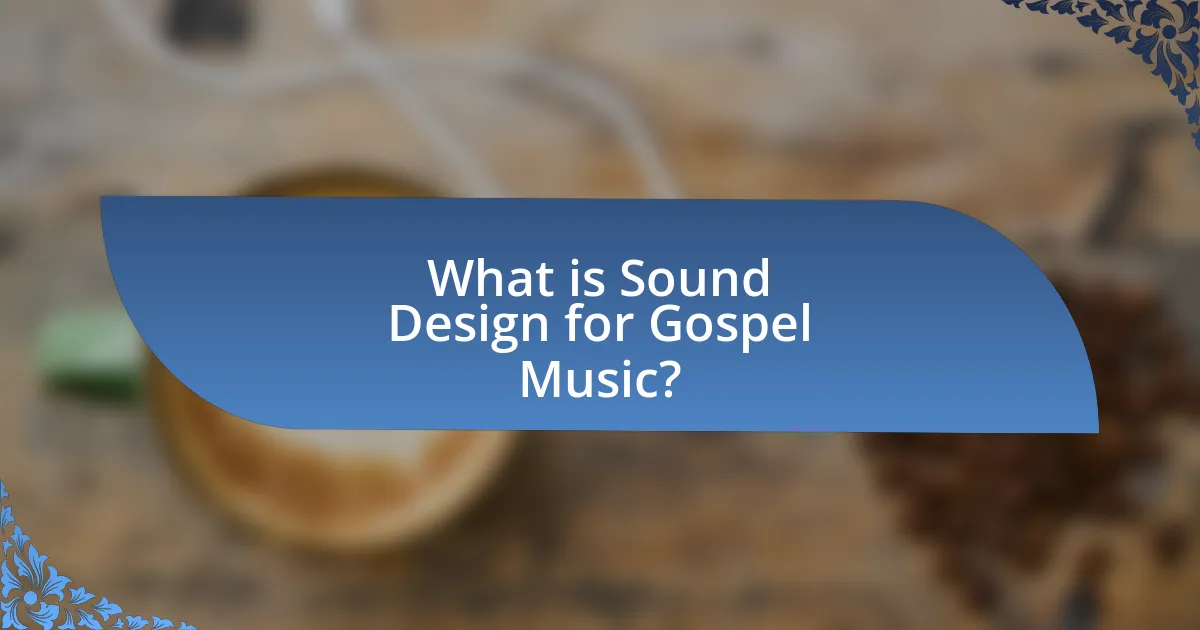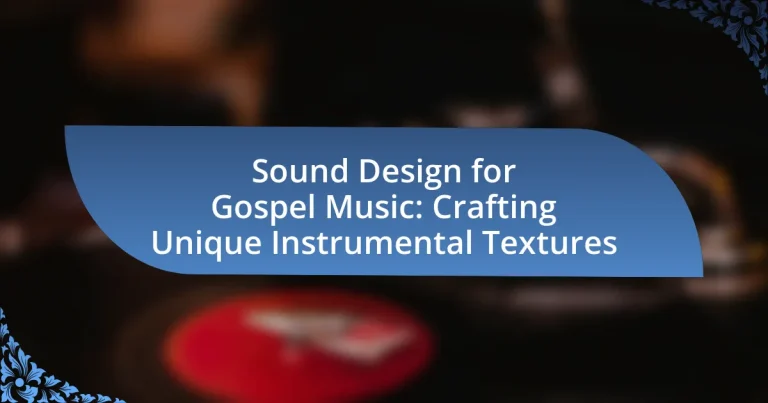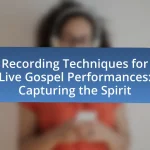Sound design for gospel music focuses on creating and manipulating audio elements to enhance the emotional and spiritual impact of the music. Key components include vocal harmonies, instrumentation, rhythm, and production techniques, which collectively contribute to the genre’s uplifting sound. Techniques such as layering, reverb, and dynamic range manipulation are essential for crafting unique instrumental textures that resonate with audiences. The article explores how sound design influences the overall experience of gospel music, the importance of cultural sensitivity, and best practices for creating memorable soundscapes while maintaining authenticity. Additionally, it addresses the challenges faced in sound design and the role of technology in enhancing both recordings and live performances.

What is Sound Design for Gospel Music?
Sound design for gospel music involves the creation and manipulation of audio elements to enhance the emotional and spiritual impact of the music. This process includes selecting instruments, arranging sounds, and applying effects that resonate with the themes of worship and praise. For instance, gospel music often utilizes rich harmonies, dynamic vocal arrangements, and instrumental textures that evoke a sense of community and upliftment. The use of specific sound design techniques, such as reverb and delay, can further amplify the atmosphere of reverence and celebration typical in gospel performances.
How does sound design influence the overall experience of gospel music?
Sound design significantly influences the overall experience of gospel music by shaping its emotional depth and sonic richness. The use of various audio elements, such as reverb, layering of instruments, and vocal harmonies, creates an immersive atmosphere that enhances the spiritual message conveyed in the music. For instance, the application of reverb can evoke a sense of space and transcendence, making listeners feel as if they are part of a larger community during worship. Additionally, the careful arrangement of instrumental textures, such as blending traditional gospel instruments with modern sounds, can resonate with diverse audiences, thereby broadening the appeal and impact of the music. This strategic sound design not only supports the lyrical content but also elevates the overall worship experience, fostering a deeper emotional connection among congregants.
What are the key elements of sound design in gospel music?
The key elements of sound design in gospel music include vocal harmonies, instrumentation, rhythm, and production techniques. Vocal harmonies are essential, often featuring rich, layered arrangements that convey emotional depth. Instrumentation typically incorporates traditional elements like piano, organ, and drums, alongside modern instruments, creating a diverse sound palette. Rhythm plays a crucial role, with syncopated patterns and strong backbeats that drive the music forward. Production techniques, such as reverb and delay, enhance the overall atmosphere, allowing for a more immersive listening experience. These elements collectively contribute to the unique and uplifting sound characteristic of gospel music.
How does sound design enhance the emotional impact of gospel music?
Sound design enhances the emotional impact of gospel music by creating immersive auditory experiences that evoke feelings of spirituality and connection. Techniques such as reverb and layering of vocal harmonies amplify the richness of the sound, allowing listeners to feel a deeper resonance with the music. For instance, the use of lush string arrangements and dynamic percussion can evoke a sense of upliftment and joy, while subtle electronic elements may introduce a modern touch that appeals to contemporary audiences. Research indicates that specific sound frequencies can trigger emotional responses, making sound design a crucial element in conveying the intended message of hope and faith in gospel music.
Why is crafting unique instrumental textures important in gospel music?
Crafting unique instrumental textures is important in gospel music because it enhances emotional expression and creates a distinctive sound that resonates with the audience. Unique textures allow musicians to convey the spiritual depth and cultural richness inherent in gospel music, making the experience more immersive. For instance, the use of varied instrumentation, such as combining traditional instruments like the organ with modern synthesizers, can evoke different emotional responses and connect with diverse congregations. This approach not only reflects the genre’s evolution but also engages listeners on a deeper level, fostering a sense of community and worship.
What role do instrumental textures play in conveying the message of gospel music?
Instrumental textures in gospel music play a crucial role in enhancing emotional expression and reinforcing the spiritual message. These textures, created through the combination of various instruments and their arrangements, contribute to the overall atmosphere of worship and reflection. For instance, the use of rich harmonies and layered instrumentation can evoke feelings of joy and celebration, while sparse textures may create a sense of solemnity and introspection. Research indicates that specific instrumental combinations, such as strings and piano, are often employed to elicit a deeper emotional response, aligning with the themes of hope and redemption prevalent in gospel music. This intentional crafting of sound not only supports the lyrical content but also engages the congregation, facilitating a more profound connection to the spiritual experience.
How can unique textures differentiate gospel music from other genres?
Unique textures in gospel music differentiate it from other genres by incorporating rich harmonies, layered vocal arrangements, and diverse instrumental elements. Gospel music often features call-and-response patterns, which create a communal and interactive sound, distinct from the more linear structures found in genres like pop or rock. Additionally, the use of traditional instruments such as the organ, piano, and choir arrangements contributes to a unique sonic landscape that emphasizes emotional expression and spiritual themes. This texture is further enhanced by the blending of various musical influences, including blues, jazz, and folk, which are not as prevalent in other genres, thus establishing a unique identity for gospel music.

What techniques are used in sound design for gospel music?
Sound design for gospel music employs techniques such as layering, reverb, and dynamic range manipulation. Layering involves combining multiple instrumental tracks to create rich textures, enhancing the emotional depth of the music. Reverb is used to simulate the acoustics of large spaces, which is essential in gospel music to evoke a sense of grandeur and spirituality. Dynamic range manipulation ensures that the softer and louder elements of the music are balanced, allowing for powerful vocal performances to shine through. These techniques collectively contribute to the unique sound and emotional impact characteristic of gospel music.
How can layering instruments create rich textures in gospel music?
Layering instruments in gospel music creates rich textures by combining different timbres and harmonies, which enhances the overall sound. This technique allows for a fuller sonic experience, as various instruments contribute unique qualities that complement each other. For instance, the combination of piano, organ, and strings can produce a lush backdrop, while vocal harmonies add depth and emotion. Research indicates that layering can increase perceived richness and complexity in music, making it more engaging for listeners. This approach is fundamental in gospel music, where emotional expression and communal participation are key elements.
What types of instruments are commonly layered in gospel sound design?
Commonly layered instruments in gospel sound design include piano, organ, guitar, bass, and drums. The piano and organ provide harmonic support and rich textures, while guitars add rhythmic and melodic elements. Bass instruments anchor the harmonic foundation, and drums contribute to the overall groove and energy of the arrangement. This layering creates a full, dynamic sound that is characteristic of gospel music, enhancing its emotional and spiritual impact.
How does layering affect the dynamics of a gospel arrangement?
Layering enhances the dynamics of a gospel arrangement by creating depth and richness in the sound. This technique involves combining multiple musical elements, such as vocals, instruments, and harmonies, which results in a fuller auditory experience. For example, layering vocal harmonies can evoke emotional responses and elevate the overall impact of the arrangement. Additionally, research indicates that well-executed layering can improve the clarity of individual parts while maintaining a cohesive sound, as seen in successful gospel recordings where instrumental textures are carefully crafted to support the vocal lines.
What role does technology play in sound design for gospel music?
Technology plays a crucial role in sound design for gospel music by enabling the creation, manipulation, and enhancement of audio elements. Digital audio workstations (DAWs) allow sound designers to layer instruments, apply effects, and edit recordings with precision, resulting in rich and dynamic soundscapes. Additionally, software synthesizers and virtual instruments provide access to a wide range of sounds that can be tailored to fit the unique style of gospel music. The use of technology also facilitates high-quality recording and mixing processes, ensuring that the final product meets professional standards. For instance, advancements in audio processing have led to clearer vocal tracks and more immersive instrumental arrangements, which are essential for conveying the emotional depth characteristic of gospel music.
Which software and tools are essential for gospel sound design?
Essential software and tools for gospel sound design include Digital Audio Workstations (DAWs) like Ableton Live, Logic Pro, and Pro Tools, as well as virtual instruments such as Native Instruments Kontakt and Spectrasonics Omnisphere. These tools enable sound designers to create rich, layered textures that are characteristic of gospel music. DAWs provide a platform for recording, editing, and mixing, while virtual instruments offer a wide range of sounds that can emulate traditional gospel instruments like organs and choirs. The effectiveness of these tools is supported by their widespread use in professional music production, demonstrating their capability to meet the specific needs of gospel sound design.
How can technology enhance live performances of gospel music?
Technology can enhance live performances of gospel music by integrating advanced sound design tools and digital effects that create unique instrumental textures. For instance, digital audio workstations (DAWs) allow musicians to layer sounds and manipulate audio in real-time, resulting in richer and more dynamic performances. Additionally, the use of high-quality microphones and sound reinforcement systems ensures that vocal harmonies and instrumental nuances are captured and amplified accurately, enhancing the overall auditory experience for the audience. Furthermore, technologies such as MIDI controllers and synthesizers enable gospel musicians to incorporate a variety of sounds and effects, expanding the traditional gospel music palette. These advancements not only improve sound quality but also allow for greater creativity and expression during live performances.

What are the challenges in sound design for gospel music?
The challenges in sound design for gospel music include balancing the rich vocal harmonies with instrumental textures, ensuring clarity in live performances, and accommodating diverse musical styles within the genre. Gospel music often features complex arrangements that require careful mixing to prevent vocal elements from being overshadowed by instruments. Additionally, achieving high sound quality in various venues can be difficult due to acoustic variations, which necessitates adaptable sound design techniques. Furthermore, gospel music incorporates a wide range of influences, from traditional hymns to contemporary styles, making it essential for sound designers to be versatile and knowledgeable about different musical elements to create a cohesive sound.
What common pitfalls should be avoided in gospel sound design?
Common pitfalls to avoid in gospel sound design include over-complexity, lack of dynamic range, and neglecting the emotional context of the music. Over-complexity can lead to a cluttered mix that detracts from the message, as gospel music often relies on clarity and emotional delivery. A lack of dynamic range can result in a flat sound that fails to engage listeners, while gospel music typically benefits from contrasts in volume and intensity to convey its spiritual themes. Additionally, neglecting the emotional context can lead to sound choices that do not resonate with the intended message, undermining the overall impact of the performance.
How can over-processing affect the authenticity of gospel music?
Over-processing can significantly diminish the authenticity of gospel music by altering its natural sound and emotional resonance. Gospel music traditionally relies on raw vocal expressions and instrumental textures that convey spiritual depth and community connection. When excessive digital effects, compression, or auto-tuning are applied, the original intent and emotional impact can be lost, leading to a polished but less genuine sound. For instance, a study by the University of Southern California found that over-produced tracks often lack the dynamic range and warmth characteristic of authentic gospel performances, which can alienate listeners seeking a true spiritual experience.
What strategies can be employed to maintain a natural sound in gospel recordings?
To maintain a natural sound in gospel recordings, employing techniques such as using high-quality microphones, capturing live performances, and minimizing excessive post-production effects is essential. High-quality microphones, like condenser mics, accurately capture the nuances of vocal performances, which is crucial in gospel music where emotion and clarity are paramount. Capturing live performances allows for the authentic energy and interaction of the musicians and vocalists to be recorded, preserving the organic feel of the music. Additionally, minimizing excessive post-production effects, such as heavy reverb or compression, helps retain the natural dynamics and tonal qualities of the instruments and voices, ensuring that the recording reflects the true sound of the performance.
How can sound designers ensure cultural sensitivity in gospel music?
Sound designers can ensure cultural sensitivity in gospel music by actively engaging with the cultural and historical contexts of the genre. This involves researching the origins and significance of gospel music, which has deep roots in African American spirituals and religious practices. By understanding the cultural narratives and values associated with gospel music, sound designers can create authentic soundscapes that respect and honor these traditions.
For instance, incorporating traditional instruments like the Hammond organ or hand claps, which are integral to gospel music, can enhance authenticity. Additionally, collaborating with gospel musicians and community leaders can provide valuable insights and feedback, ensuring that the sound design aligns with the cultural expectations and emotional expressions of the genre. This approach not only fosters respect but also enriches the overall musical experience, making it more relatable and meaningful to the audience.
What considerations should be made regarding the origins of gospel music?
The origins of gospel music should be considered in terms of its historical context, cultural influences, and musical elements. Gospel music emerged in the African American communities in the United States during the late 19th century, influenced by spirituals, hymns, and blues. This genre reflects the struggles and resilience of African Americans, often incorporating call-and-response patterns and emotive vocal styles that are rooted in African musical traditions. The integration of these elements not only shaped the sound of gospel music but also its role as a form of expression and community solidarity. Understanding these origins is crucial for sound design in gospel music, as it informs the choice of instruments, vocal techniques, and overall texture that resonate with the genre’s rich heritage.
How can sound design respect and honor the traditions of gospel music?
Sound design can respect and honor the traditions of gospel music by incorporating authentic instrumentation and vocal techniques that reflect its cultural roots. Utilizing traditional instruments such as the piano, organ, and choir harmonies preserves the essence of gospel music, which is deeply rooted in African American spirituals and church traditions. Additionally, sound designers can employ techniques like reverb and delay to create a spacious, uplifting atmosphere that mirrors the communal experience of gospel worship. This approach not only maintains the genre’s historical context but also enhances the emotional impact of the music, ensuring that the sound remains true to its origins while appealing to contemporary audiences.
What are best practices for crafting unique instrumental textures in gospel music?
Best practices for crafting unique instrumental textures in gospel music include utilizing a diverse range of instruments, layering sounds, and incorporating dynamic contrasts. Gospel music often features a blend of traditional and contemporary instruments, such as pianos, organs, strings, and electronic elements, which can create rich textures. Layering involves combining multiple sounds or harmonies to enhance depth; for instance, adding vocal harmonies or background instrumentation can enrich the overall sound. Dynamic contrasts, such as varying volume levels and intensity throughout a piece, help to maintain listener engagement and highlight emotional moments. These techniques are supported by the genre’s historical evolution, which has embraced innovation while maintaining its roots in spiritual expression.
How can collaboration with musicians enhance sound design in gospel music?
Collaboration with musicians enhances sound design in gospel music by integrating diverse musical perspectives and techniques, resulting in richer and more innovative soundscapes. When musicians from various backgrounds contribute their unique styles and skills, they introduce new instruments, harmonies, and rhythms that can transform traditional gospel elements. For instance, incorporating jazz or blues influences can add complexity to arrangements, while the use of modern technology can create unique audio effects. This collaborative approach not only broadens the sonic palette but also fosters creativity, leading to the development of distinctive instrumental textures that resonate with contemporary audiences.
What tips can help sound designers create memorable instrumental textures in gospel music?
Sound designers can create memorable instrumental textures in gospel music by incorporating rich harmonic layers, utilizing dynamic instrumentation, and integrating spatial effects. Rich harmonic layers enhance the emotional depth of the music, as gospel often relies on complex chords and vocal harmonies. Dynamic instrumentation, including a mix of traditional and contemporary instruments, allows for a diverse sound palette that resonates with the audience. Spatial effects, such as reverb and delay, create a sense of atmosphere and depth, which is essential in gospel music to evoke a spiritual experience. These techniques are supported by the genre’s historical emphasis on emotional expression and communal worship, making them effective in crafting unique instrumental textures.


